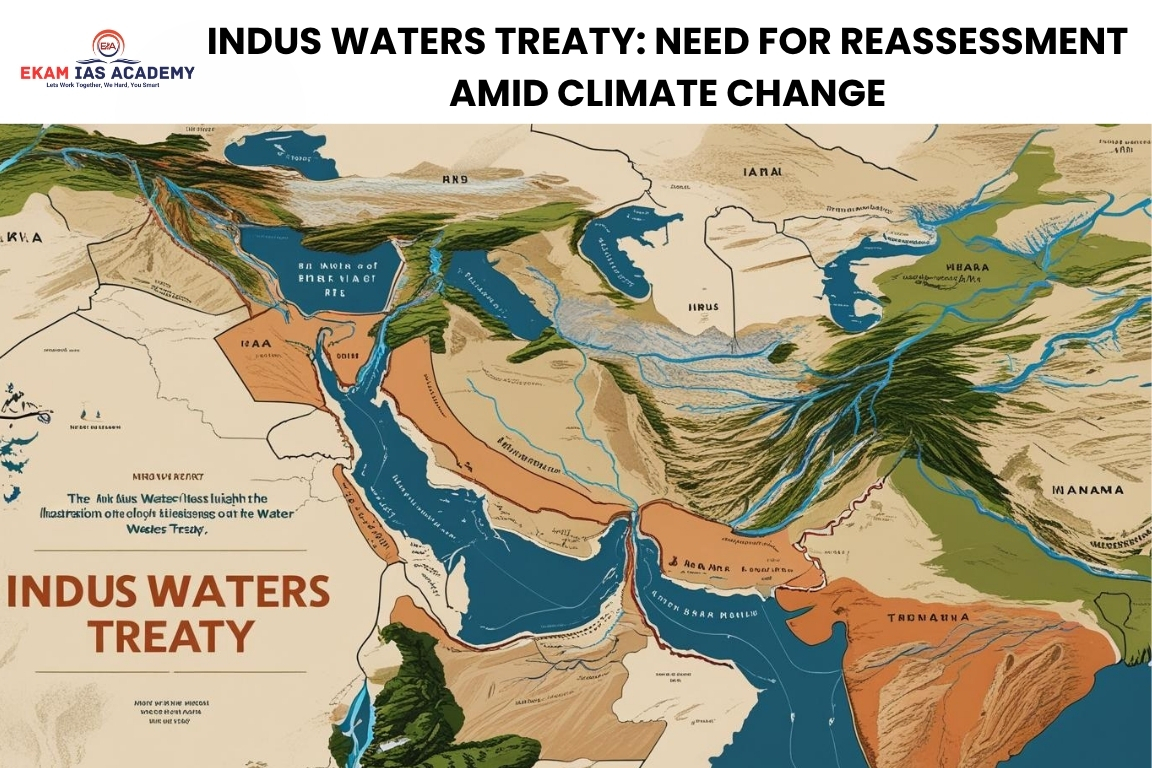Introduction
In light of recent cross-border terror attacks, including the Pahalgam incident that killed 26 Indian tourists, India has decided to put the Indus Waters Treaty (IWT) on hold. India also emphasizes the urgent need to reassess the treaty considering the mounting climate change pressures like glacial melt and changing river flows.
Background of the Indus Waters Treaty
Origin and Purpose
- The Indus Waters Treaty was signed in 1960 between India and Pakistan, brokered by the World Bank.
- It allocates the:
- Eastern Rivers (Ravi, Beas, Sutlej) to India
- Western Rivers (Indus, Jhelum, Chenab) to Pakistan
Durability of the Treaty
- The treaty has survived multiple wars and conflicts, becoming a symbol of functional diplomacy.
- However, recent hostilities and terror activities have strained this cooperative arrangement.
Keywords: Indus Waters Treaty, India Pakistan Water Dispute, IWT 1960, Indus River Basin
Why the Treaty Needs Revision
1. Changed Geopolitical Scenario
- In 1960, both nations had smaller populations and limited urbanization.
- Today:
- India’s population exceeds 1.46 billion
- Pakistan’s population stands at 255 million
- Increased urban demand, industrialization, and terror attacks demand a fresh diplomatic approach.
2. Climate Change Effects
- Melting glaciers from the Himalayas are altering seasonal river flows.
- Heatwaves, floods, and droughts are more frequent and intense.
- The 1960 treaty does not account for climate variability or sustainability concerns.
3. Water Mismanagement
- Focus has been more on increasing water supply rather than reducing demand.
- Agriculture consumes 85–90% of water in both nations.
- Groundwater tables are depleting rapidly, especially in Punjab.
4. Rising Urban and Energy Demand
- Urban populations are growing, increasing domestic and industrial water needs.
- Extreme temperatures raise electricity demands, and power plants require water for cooling, further straining water systems.
Keywords: Climate Change and Indus Treaty, Water Security India Pakistan, Groundwater Crisis India Pakistan
Missing Elements in the Treaty
- The current IWT focuses solely on surface water allocation, neglecting:
- Groundwater usage
- Water quality and pollution controls
- Demand-side efficiency
- Lacks flexibility to adapt to evolving climate, demographic, and political realities.
Keywords: Indus Treaty Limitations, Surface Water vs Groundwater, Indus Basin Water Management
Way Forward
- Both countries must move toward a modernized and climate-resilient treaty.
- Steps to consider:
- Include climate change adaptation mechanisms
- Promote joint hydrological data sharing
- Build flexible and dynamic water governance frameworks
- Encourage agricultural efficiency and water conservation
Rivers Included in the Indus Waters Treaty
Rivers Allocated to Pakistan
- Indus River: Originates in Tibet, flows through Ladakh to Pakistan
- Jhelum River: Originates in Verinag, J&K, flows to Pakistan
- Chenab River: Originates in Himachal Pradesh, flows through J&K to Pakistan
Rivers Allocated to India
- Ravi River: Originates in Himachal Pradesh, flows along the India-Pakistan border
- Beas River: Entirely in India, joins the Sutlej
- Sutlej River: Originates in Tibet, flows through India into Pakistan
Keywords: Indus River System, Indus Basin Rivers, India Pakistan River Distribution
Conclusion
With rising geopolitical tensions and accelerating climate change impacts, the Indus Waters Treaty must transition from a rigid 1960s framework to a modern, adaptive, and cooperative water-sharing agreement. Only through mutual understanding, sustainability-focused governance, and climate-aware diplomacy can long-term peace and water security in the region be ensured.
Keywords to Target: Indus Waters Treaty Reassessment, Climate Change Water Treaty, India Pakistan Water Conflict, Modernizing IWT, Indus Treaty Revision 2025





